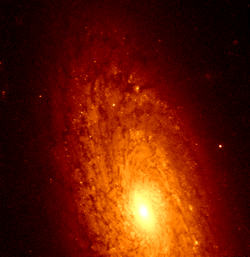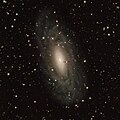| NGC 2090 | |
|---|---|
 NGC 2090 captured by the Hubble Space Telescope in 2015. | |
| Observation data (J2000 epoch) | |
| Constellation | Columba |
| Right ascension | 05h 48m 22.3s[1] |
| Declination | −34° 13′ 37″[1] |
| Redshift | 0.003079[2] |
| Heliocentric radial velocity | 921.5 km/s[2] |
| Distance | 40.1 ± 2.9 Mly (12.3 ± 0.9 Mpc)[1] |
| Apparent magnitude (V) | 11.20[3] |
| Apparent magnitude (B) | 11.99[3] |
| Characteristics | |
| Type | SA:(rs)c[3] |
| Apparent size (V) | 4.9′ × 2.4′[3] |
| Other designations | |
| MCG -06-13-009, PGC 17819[2] | |
NGC 2090 is a spiral galaxy located approximately 40 million light-years from the Solar System[1] in the Columba constellation. It was discovered on 29 October 1826 by Scottish astronomer James Dunlop.[4] NGC 2090 was studied to refine the Hubble constant to an accuracy within ±10%.[1]
See also
[edit]Gallery
[edit]-
NGC 2090 by GALEX
-
DSS image of NGC 2090
-
NGC 2090 with the legacy surveys
-
JWST MIRI image
References
[edit]- ^ a b c d e Phelps, Randy L.; Sakai, Shoko; Freedman, Wendy L.; Madore, Barry F.; Saha, Abhijit; Stetson, Peter B.; Kennicutt, Robert C.; Mould, Jeremy R.; Ferrarese, Laura; Ford, Holland C.; Gibson, Brad K.; Graham, John A.; Han, Mingsheng; Hoessel, John G.; Huchra, John P.; Hughes, Shaun M.; Illingworth, Garth D.; Silbermann, N. A. (1998). "The Hubble Space Telescope Extragalactic Distance Scale Key Project. IX. The Discovery of Cepheids in NGC 2090". The Astrophysical Journal. 500 (2): 763–788. Bibcode:1998ApJ...500..763P. doi:10.1086/305766.
- ^ a b c "NGC 2090". SIMBAD. Centre de données astronomiques de Strasbourg. Retrieved 2021-02-25.
- ^ a b c d Gil de Paz, Armando; et al. (December 2007). "The GALEX Ultraviolet Atlas of Nearby Galaxies". The Astrophysical Journal Supplement Series. 173 (2): 185–255. arXiv:astro-ph/0606440. Bibcode:2007ApJS..173..185G. doi:10.1086/516636. S2CID 119085482.
- ^ "New General Catalog Objects: NGC 2050 - 2099". cseligman.com. Retrieved 2017-12-14.
External links
[edit]- NGC 2090 on WikiSky: DSS2, SDSS, GALEX, IRAS, Hydrogen α, X-Ray, Astrophoto, Sky Map, Articles and images
- SEDS




Well, that’s interesting to know that Psilotum nudum are known as whisk ferns. Psilotum nudum is the commoner species of the two. While the P. flaccidum is a rare species and is found in the tropical islands. Both the species are usually epiphytic in habit and grow upon tree ferns. These species may also be terrestrial and grow in humus or in the crevices of the rocks.
View the detailed Guide of Psilotum nudum: Detailed Study Of Psilotum Nudum (Whisk Fern), Classification, Anatomy, Reproduction